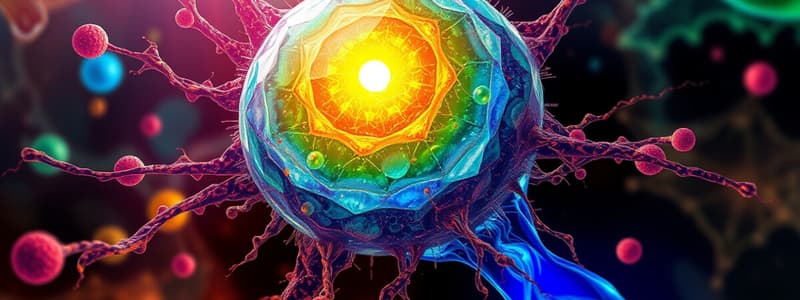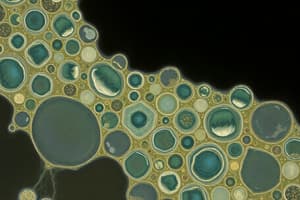Podcast
Questions and Answers
Which statement accurately reflects the principles of cell theory?
Which statement accurately reflects the principles of cell theory?
- Cells are unable to reproduce or give rise to new cells.
- The cell is the largest unit of life, comprising all living organisms.
- All living organisms are composed of one or more cells. (correct)
- All cells can arise spontaneously without any pre-existing cells.
What is a primary characteristic of prokaryotic cells?
What is a primary characteristic of prokaryotic cells?
- They lack a nucleus and are generally smaller. (correct)
- They are typically larger and more complex than eukaryotic cells.
- They contain a nucleus and membrane-bound organelles.
- They are exclusively found in multicellular organisms.
Which cell organelle is responsible for ATP production?
Which cell organelle is responsible for ATP production?
- Ribosomes
- Golgi Apparatus
- Mitochondria (correct)
- Lysosomes
What distinguishes meiosis from mitosis?
What distinguishes meiosis from mitosis?
Which process describes the breakdown of molecules to release energy?
Which process describes the breakdown of molecules to release energy?
Which transport mechanism requires energy to move molecules against their concentration gradient?
Which transport mechanism requires energy to move molecules against their concentration gradient?
What is the primary function of the Golgi Apparatus?
What is the primary function of the Golgi Apparatus?
What is the semi-permeable barrier that regulates the movement of substances in and out of the cell?
What is the semi-permeable barrier that regulates the movement of substances in and out of the cell?
Flashcards are hidden until you start studying
Study Notes
Cell Biology
Definition
- Study of the structure, function, and behavior of cells.
Cell Theory
- All living organisms are composed of one or more cells.
- The cell is the basic unit of life.
- All cells arise from pre-existing cells.
Types of Cells
-
Prokaryotic Cells
- Lack a nucleus and membrane-bound organelles.
- Typically smaller and simpler.
- Examples: Bacteria and Archaea.
-
Eukaryotic Cells
- Have a nucleus and membrane-bound organelles.
- Larger and more complex.
- Examples: Animal cells, plant cells, fungi, and protists.
Cell Structure
-
Cell Membrane
- Semi-permeable barrier that regulates the movement of substances in and out of the cell.
-
Nucleus
- Contains the cell's genetic material (DNA).
- Controls cell activities and reproduction.
-
Cytoplasm
- Jelly-like fluid that fills the cell and holds organelles in place.
-
Organelles
- Mitochondria: Powerhouse of the cell; site of energy (ATP) production.
- Ribosomes: Sites of protein synthesis.
- Endoplasmic Reticulum:
- Rough ER: Studded with ribosomes; involved in protein synthesis.
- Smooth ER: Lacks ribosomes; involved in lipid synthesis.
- Golgi Apparatus: Modifies, sorts, and packages proteins and lipids.
- Lysosomes: Contain digestive enzymes for breaking down waste.
Cell Division
-
Mitosis
- Process of asexual reproduction in somatic (body) cells.
- Results in two genetically identical daughter cells.
-
Meiosis
- Process of sexual reproduction; produces gametes (sperm and eggs).
- Results in four genetically varied daughter cells.
Cellular Metabolism
- Catabolism: Breakdown of molecules to release energy.
- Anabolism: Building up molecules using energy.
Cell Communication
- Cells communicate through signals and receptors, including:
- Hormones
- Neurotransmitters
- Cell surface proteins
Transport Mechanisms
-
Passive Transport
- Movement of molecules across the cell membrane without energy input.
- Examples: Diffusion, osmosis, facilitated diffusion.
-
Active Transport
- Movement of molecules against their concentration gradient, requiring energy (ATP).
- Example: Sodium-potassium pump.
Cellular Respiration
- Process by which cells convert glucose and oxygen into energy (ATP), carbon dioxide, and water.
- Stages: Glycolysis, Krebs Cycle, and Electron Transport Chain.
Importance of Cell Biology
- Understanding cell structure and function is crucial for advancements in medicine, biotechnology, and environmental science.
Cell Biology Overview
- Focuses on the structure, function, and behavior of cells, the building blocks of life.
Cell Theory
- All living organisms consist of one or more cells.
- The cell is recognized as the basic unit of life.
- New cells arise only from the division of existing cells.
Types of Cells
- Prokaryotic Cells
- Do not have a nucleus or membrane-bound organelles.
- Typically smaller and less complex than eukaryotic cells.
- Examples include Bacteria and Archaea.
- Eukaryotic Cells
- Contain a nucleus and membrane-bound organelles.
- Generally larger and more complex.
- Examples include animal cells, plant cells, fungi, and protists.
Cell Structure
- Cell Membrane
- A semi-permeable barrier that controls substance movement in and out of cells.
- Nucleus
- Houses the cell’s genetic material (DNA) and regulates cell activities and reproduction.
- Cytoplasm
- A gel-like substance filling the cell that supports organelles.
- Organelles
- Mitochondria: Energy production site, often referred to as the powerhouse of the cell.
- Ribosomes: Locations for protein synthesis.
- Endoplasmic Reticulum:
- Rough ER: Involved in protein synthesis, covered with ribosomes.
- Smooth ER: Involved in lipid synthesis, lacking ribosomes.
- Golgi Apparatus: Modifies, sorts, and packages proteins and lipids for distribution.
- Lysosomes: Contain digestive enzymes for breaking down cellular waste.
Cell Division
- Mitosis
- A method of asexual reproduction resulting in two genetically identical daughter cells.
- Meiosis
- A type of cell division for sexual reproduction producing gametes; results in four genetically varied daughter cells.
Cellular Metabolism
- Catabolism: The process of breaking down molecules to release energy.
- Anabolism: The process of building up molecules that require energy input.
Cell Communication
- Cells utilize various signals and receptors for communication, including:
- Hormones
- Neurotransmitters
- Cell surface proteins.
Transport Mechanisms
- Passive Transport
- Movement of molecules across the membrane without energy use, includes diffusion, osmosis, and facilitated diffusion.
- Active Transport
- Requires energy to move molecules against their concentration gradient, exemplified by the sodium-potassium pump.
Cellular Respiration
- The process of converting glucose and oxygen into energy (ATP), water, and carbon dioxide, comprising three stages:
- Glycolysis
- Krebs Cycle
- Electron Transport Chain.
Importance of Cell Biology
- Insights into cell structure and function are vital for medical advancements, biotechnology developments, and understanding environmental science.
Studying That Suits You
Use AI to generate personalized quizzes and flashcards to suit your learning preferences.




